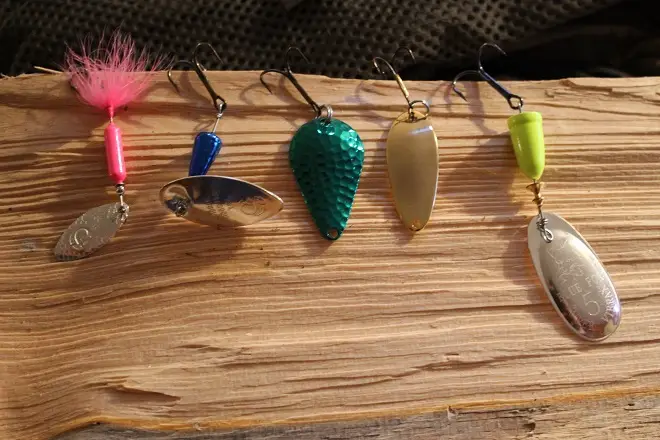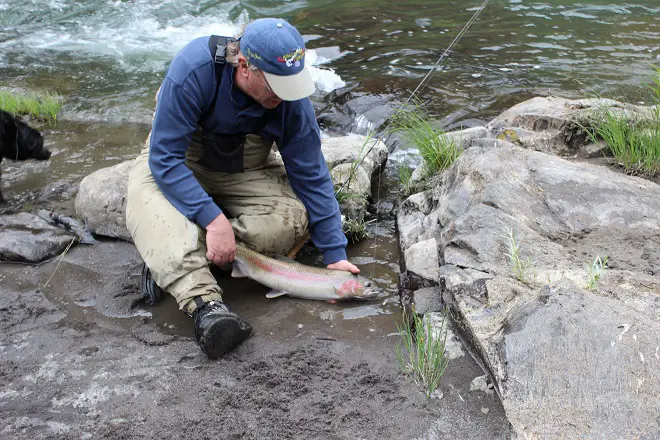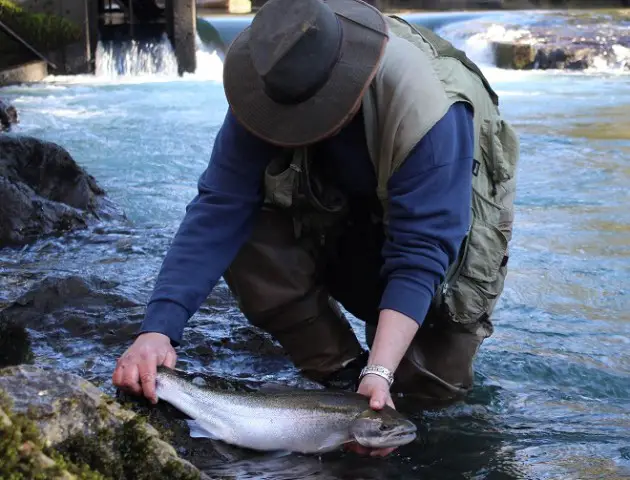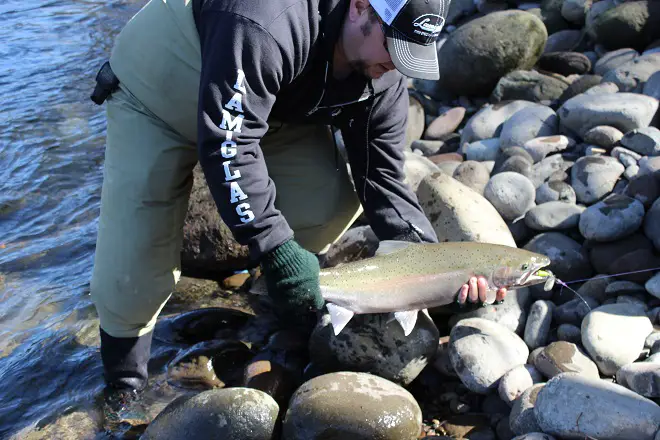Search
Latest Articles
Steelhead Hardware Primer
by By Terry Otto for Anglers Club Magazine, October 01, 2016
The big, wild steelhead had inhaled the lure, but I had switched the treble hooks out for a single hook, so I released the big hen without hurting her.

photo credit Terry Otto This winter steelhead fell to a Blue Fox Vibrax retrieved through the head of a pool. The aggressive fish carried a broken-off leader in its jaw.
Steelhead are suckers for high quality gear. Flashy spinners and spoons aggravate these territorial fish until they have to show it whose boss. Easily detectable strikes and the ease of working these baits make them a popular choice for veteran anglers and newbies alike.

The best of steelhead hardware. From left to right: 1 Worden’s Rooster Tail. 2 Rooster tail Vibric 3 Acme Stee-Lee. 4 Little Cleo. 5 Blue Fox Vibrax.
Since they are so effective there is a plethora of steelhead hardware out there to choose from, all designed to get the attention ofOnchorynchus mykiss. Let’s sort through the many options, and discuss some of the best and most popular spinners and spoons on the market for steelhead today.
Hardware will work on both winter and summer steelhead, so if you find me casting for metalheads, no matter the time of year, these proven steelhead baits will be in my vest.
#1: Blue Fox Vibrax
This is without a doubt the most popular spinner in the Northwest for steelhead, and for good reason. They work, simple as that. In fact, “simple” can describe the basic design of this versatile bait, and it comes in a dizzying array of sizes and colors. If the guy next to you is throwing a spinner for steelhead, there’s a 90% chance he is throwing a Blue Fox.
Sizes 3 through 5 work best for steelhead, and popular colors include red, blue, or chartreuse. In very clear water a gold or bronze blade will work well, and in dirty water silver is best.
#2: Stee-Lee Spoons
This steelhead spoon made by ACME is one of the most effective and versatile on the market. They work well when retrieved fast or slow, and are deadly when they are swung through a tailout. They fish well in no-flow frog water, and can even be jigged.
The ½ oz. size is what the steelhead want, and they come in a nice selection of colors. Every stream is different, but the green and blue colors seem the best for winter steelhead. For summer steelhead the red and white pattern is good, but don’t forget that green! In the right conditions, summer steelhead love green, too.
#3:Worden’s Rooster Tail Spinner
The Rooster Tail has long been a favorite of steelheaders everywhere, although they do not seem as common as they were 15 years ago. This is odd, because they still work. They present a different profile than the Blue Fox, and the spin is less pronounced, offering the fish a fresh look after watching hundreds of Blue Fox go by.
Worden’s recently introduced a new spinner called the Rooster Tail Vibric, with a shaft-through blade design and a weighted keel to reduce line twist. These new lures come in most good steelhead patterns and colors.
#4:Little Cleo Spoon
Another simply designed spoon, the little Cleo offers a wider range of sizes than the Stee-Lee, but with fewer color choices. They are extremely effective in many conditions, and when the fish want a smaller spoon, you can offer them one.
Summer steelhead, in particular, seem to favor the Little Cleo in the smaller sizes. Try the gold color, but if the water is dirty, switch to silver.

The author cradles a wild summer steelhead before release. This one took a bronze Little Cleo.
Tips for Fishing Steelhead Hardware
Fishing steelhead with artificial lures is easy. Cast slightly upstream and retrieve fast enough to keep the lure working and off the bottom. As the lure swings downstream the current will grab the lure, allowing you to slow your retrieve. Be sure to let the lure swing across the entire stream before retrieving.
Steelhead will often take a lure as it is retrieved downstream through the head of a pool. For this application, a spinner seems to work best. Cast a good ways upstream and across the current. You will have to retrieve fairly fast to keep the blade turning as it moves with the current to keep it from getting snagged. There’s something about that flashing spinner barreling downstream toward them that makes the territorial steelhead crazy, and they lash out angrily.

photo credit Terry Otto Aggressive, wild steelhead will often engulf a spinner or spoon, so change out the treble hooks for single siwash hooks. This will decrease mortality significantly for native steelhead.
Steelhead will often take a lure swung downstream, too, and for this approach, a spoon is the ticket. You can cast out even with yourself, and by keeping just enough pressure on the bait to make it work, let it swing though as much water as possible.
Spoons can be used to back steelhead down a tail-out, much like a plug will. The idea is to work the tailout from top to bottom, letting the lure swing a little farther downstream with each cast. Steelhead will back away from the lure until they get angry, and then its fish on.
Hardware works best in the kind of water steelhead like; the somewhat faster flows of the heads and tailouts of pools, as well as glides and boulder-strewn runs. Artificials will also work in water with little or no flow. Summer steelhead, in particular, will school up in cold, deep, pools. Hardware will work in this situation, but you will need to vary your retrieve speed until you find what the fish want.
Also, try stopping your retrieve and letting the lure fall from time to time. This tactic will often draw bites when a straight retrieve will not.
Hunting Steelhead with Hardware
Perhaps the best use of steelhead hardware is as a hunting lure. You can really cover a lot of water very quickly with hardware, and it’s a great way to find the aggressive steelhead. Once you have located the schools you can switch to finesse tactics such as float fishing, or drifting yarn.

The author casts a spinner for summer steelhead on the Deschutes River in Oregon. Both summer and winter-run steelhead are suckers for hardware.
This makes steelhead hardware a great choice when you are trying to learn a new river. A day or two with a spinner can tell you a lot about the steelhead in a river. As with any bait, there are times when the fish will ignore hardware, but spinners and spoons are too effective to leave at home.
Photos by Terry & Jeff Otto
-2.jpg)





